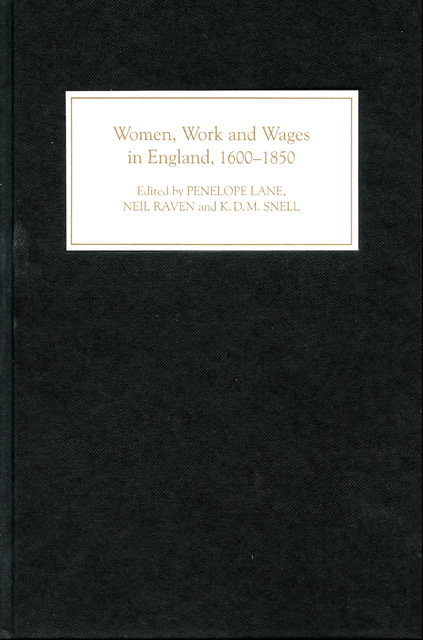Book contents
- Frontmatter
- Contents
- Illustrations
- Notes on Contributors
- Acknowledgements
- Introduction
- 1 ‘Waste’ Children? Pauper Apprenticeship Under the Elizabethan Poor Laws, c. 1598–1697
- 2 Gender at Sea: Women and the East India Company in Seventeenth-Century London
- 3 Sickles and Scythes Revisited: Harvest Work, Wages and Symbolic Meanings
- 4 A Customary or Market Wage? Women and Work in the East Midlands, c. 1700–1840
- 5 ‘Meer Pennies for My Baskitt Will be Enough’: Women, Work and Welfare, 1770–1830
- 6 Caring for the Sick Poor: Poor Law Nurses in Bedfordshire, c. 1770–1834
- 7 ‘A ‘Humbler, Industrious Class of Female’: Women’s Employment and Industry in the Small Towns of Southern England, c. 1790–1840
- 8 A Diminishing Force? Reassessing the Employment of Female Day Labourers in English Agriculture, c. 1790–1850
- Bibliography
- Index
2 - Gender at Sea: Women and the East India Company in Seventeenth-Century London
Published online by Cambridge University Press: 21 March 2023
- Frontmatter
- Contents
- Illustrations
- Notes on Contributors
- Acknowledgements
- Introduction
- 1 ‘Waste’ Children? Pauper Apprenticeship Under the Elizabethan Poor Laws, c. 1598–1697
- 2 Gender at Sea: Women and the East India Company in Seventeenth-Century London
- 3 Sickles and Scythes Revisited: Harvest Work, Wages and Symbolic Meanings
- 4 A Customary or Market Wage? Women and Work in the East Midlands, c. 1700–1840
- 5 ‘Meer Pennies for My Baskitt Will be Enough’: Women, Work and Welfare, 1770–1830
- 6 Caring for the Sick Poor: Poor Law Nurses in Bedfordshire, c. 1770–1834
- 7 ‘A ‘Humbler, Industrious Class of Female’: Women’s Employment and Industry in the Small Towns of Southern England, c. 1790–1840
- 8 A Diminishing Force? Reassessing the Employment of Female Day Labourers in English Agriculture, c. 1790–1850
- Bibliography
- Index
Summary
Journalistic comment on the recent anti-globalization protests make the assumption that multinational trade, where companies take on some of the functions of nations, is a modern phenomenon. Yet the East India Companies of the various states of the seventeenth century present some similar circumstances, and the English East India Company has recently celebrated its 400th anniversary. As the major historian of the English East India Company, Chaudhuri, put it: ‘In many ways, the East India Company was the direct ancestor of the modern giant business firm, handling a multitude of trading products and operating in an international setting.’ The East India Company traded on the seas – the pre-eminent commercial realm of the early modern period – but also their operations included quasi-banking functions, property management and a role in the relief of poverty.
A very large part of the lives of those who worked for the East India Company became inextricably connected with its fortunes. In this light, I have always had difficulty with a remark that the early modern historian Olwen Hufton, perhaps offhandedly, made in her article about women without men in the eighteenth century. Hufton stated: ‘There was no East India Company for women’ when arguing that while single men had difficulties in forging a business career if they had no access to business networks and patronage, this could not be compared with the plight of the single woman. Yet, as I will show here, the all-encompassing presence of the East India Company did make a material difference to the lives of widows and to other women in a number of ways.
There is scant historiography of women in seafaring communities. The picture we can develop comes from court records or poor law accounts, such as the ‘Voices of Londoners’ cited by Peter Earle in A City Full of People for the period 1650 to 1750: ‘I endeavor to maintaine myself and my family by winding of silke’, said a sailor’s wife;
‘In the absence of my husband (who is at sea) I sell bisketts by which and other work as of sewing… I get a living’, said another.
- Type
- Chapter
- Information
- Women, Work and Wages in England, 1600-1850 , pp. 47 - 67Publisher: Boydell & BrewerPrint publication year: 2004
- 4
- Cited by

